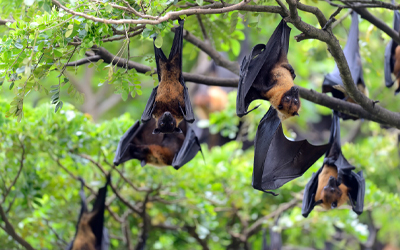 Have you noticed an uptick in winged visitors around your home? Bats and birds often seek refuge in residential areas, and understanding their motivations can help you manage their presence effectively. Here are some common reasons why these creatures might be attracted to your property and how you can address the issue.
Have you noticed an uptick in winged visitors around your home? Bats and birds often seek refuge in residential areas, and understanding their motivations can help you manage their presence effectively. Here are some common reasons why these creatures might be attracted to your property and how you can address the issue.
Shelter and Nesting Sites
Bats: Nocturnal mammals that look for safe, dark, and quiet places to roost during the day. Attics, eaves, and chimneys provide ideal conditions. These spots offer protection from predators and harsh weather, making them prime real estate for bats looking to establish a colony.
Birds: Birds seek out areas that offer good nesting sites. Trees, shrubs, and even the nooks and crannies of buildings can provide the perfect environment for raising their young. Some species, like swallows and sparrows, are particularly fond of nesting in the eaves and gutters of houses.
Abundant Food Sources
Bats: Bats feed on insects, abundant in areas with lights. Outdoor lighting attracts insects, creating a convenient feeding ground for bats. If your home has ample lighting, especially around entryways and gardens, it’s like setting up a buffet for these nocturnal hunters.
Birds: Birds are attracted to areas with readily available food sources. Bird feeders, gardens with various plants, and lawns rich in insects provide an all-you-can-eat buffet for our feathered friends. Additionally, fruit trees and berry bushes can attract birds looking for a quick and easy meal.
Water Availability
Both bats and birds need water for drinking and bathing. Features like birdbaths, ponds, and pet water bowls can draw them to your property. A reliable water source becomes even more critical in hot weather, turning your home into a hydration hub for wildlife.
Safe Haven
Urban areas can provide a relatively safe environment for bats and birds compared to the wild. The absence of natural predators, the availability of nesting sites, and the abundance of food make residential areas attractive.
Light Pollution
Artificial lighting, while beneficial for humans, can disorient and attract wildlife. Birds, in particular, can be drawn to the lights during migration periods, leading them to rest or nest nearby. Similarly, lights attract insects, which in turn attract bats.
How to Manage Wildlife Around Your Home
If bats and birds have become a nuisance, here are some steps you can take to manage their presence:
Seal Entry Points: Inspect your home for potential entry points and seal them. It includes gaps in roofing, siding, and around windows and doors. Ensure that chimneys have caps and that vents are properly screened.
Reduce Food Sources: Remove or cover outdoor food sources. Think about putting your bird feeders farther away from the house if you have any. Keep your garden tidy and free of fallen fruit and seeds that can attract birds.
Manage Water Sources: Limit standing water around your home. Ensure birdbaths are cleaned regularly and consider placing them away from the house.
Control Lighting: Use outdoor lighting judiciously. Opt for motion-activated lights instead of constant lighting to reduce insect attraction. Use warm-colored lights that are less likely to attract insects.
Install Deterrents: Use bird spikes, netting, or reflective materials to deter birds from nesting in unwanted areas. Ultrasonic devices and bat houses can encourage bats to roost away from your home.
Professional Help: If wildlife presence becomes unmanageable, consider contacting a professional wildlife removal service. They can safely and humanely remove bats and birds and help you implement long-term prevention strategies.
Bats and birds are drawn to residential areas for shelter, food, water, and safety. While their presence can be beneficial, such as controlling insect populations, it can lead to issues if not appropriately managed. Homeowners can ensure a harmonious balance between wildlife and human habitats by proactively coexisting peacefully with these fascinating creatures and understanding their needs and behaviors. For more help and professional guidance, contact wildlife removal experts like AAA Kyles Wildlife Removal.
